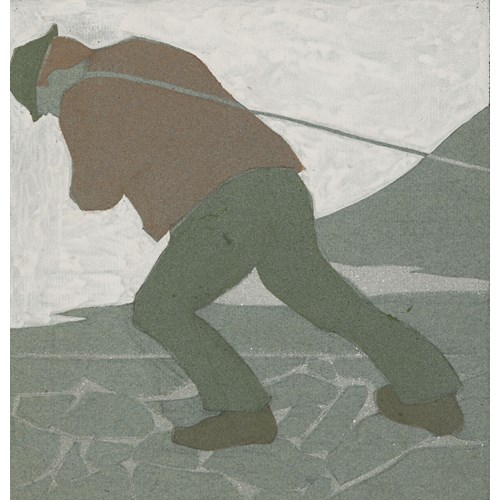Marketplace
The Grand Bridge at Blenheim Palace, Oxfordshire
Joseph Mallord William Turner
The Grand Bridge at Blenheim Palace, Oxfordshire
In the summer of 1830, while on a tour of the Midlands to collect material for his illustrations for Charles Heath’s publication Picturesque Views in England and Wales, on which J. M. W. Turner worked between 1826 and 1838, the artist visited Blenheim Palace in Oxfordshire, the seat of the Dukes of Marlborough. In his ‘Kenilworth Sketchbook’, now part of the Turner Bequest at Tate Britain, he recorded in pencil studies the architecture of the Palace, built to the designs of Sir John Vanbrugh between 1705 and 1722, as well as the surrounding park and gardens later designed by Lancelot ‘Capability’ Brown. Upon his return to London, Turner began to consider possible compositions for a large watercolour of Blenheim and its surroundings, which eventually resulted in the finished watercolour of Blenheim Palace and Park, Oxfordshire, painted in the late autumn and winter of 1830-1831 and today in the Birmingham Museum and Art Gallery. The same view also appears, engraved by William Radclyffe, in Picturesque Views in England and Wales, published in 1833.
The 18th century Grand Bridge at Blenheim, built by Vanbrugh in 1708, was more than 120 metres in length and some fifteen metres tall, with a central arch that was thirty metres wide. When Capability Brown transformed Blenheim’s grounds in the 1760s, he built two dams and a huge lake, which flooded the lower half of Vanbrugh’s bridge.
The present sheet may be grouped with a large number of rapidly drawn watercolours by Turner that have been defined, by Alexander Finberg in his 1909 inventory of the Turner Bequest at the Tate, as ‘Colour Beginnings’. Finberg was referring to a miscellaneous group of 386 watercolours in the Turner Bequest - including numerous colour sketches, as well as preparatory studies, test sheets, and finished and unfinished watercolours - spanning a period of more than thirty years of the artist’s career.
This large watercolour depicts Blenheim Palace and its grounds from the Woodstock Gate, the main entrance to the park. Two other ‘colour beginnings’ of Blenheim, both in the Turner Bequest at the Tate, depict the house and its grounds. One of these is quite close in composition to both the finished watercolour and the present sheet, while the other sketch shows the park at Blenheim from a different viewpoint, looking southeast, across the lake. Both works share with the present sheet a great sense of freedom and a summery palette.
A recent owner of the present sheet was the Conservative politician Philip Cunliffe-Lister, 1st Earl of Swinton (1884-1972), who was a prominent figure in British politics and a government minister from the 1920s to the 1950s.
The 18th century Grand Bridge at Blenheim, built by Vanbrugh in 1708, was more than 120 metres in length and some fifteen metres tall, with a central arch that was thirty metres wide. When Capability Brown transformed Blenheim’s grounds in the 1760s, he built two dams and a huge lake, which flooded the lower half of Vanbrugh’s bridge.
The present sheet may be grouped with a large number of rapidly drawn watercolours by Turner that have been defined, by Alexander Finberg in his 1909 inventory of the Turner Bequest at the Tate, as ‘Colour Beginnings’. Finberg was referring to a miscellaneous group of 386 watercolours in the Turner Bequest - including numerous colour sketches, as well as preparatory studies, test sheets, and finished and unfinished watercolours - spanning a period of more than thirty years of the artist’s career.
This large watercolour depicts Blenheim Palace and its grounds from the Woodstock Gate, the main entrance to the park. Two other ‘colour beginnings’ of Blenheim, both in the Turner Bequest at the Tate, depict the house and its grounds. One of these is quite close in composition to both the finished watercolour and the present sheet, while the other sketch shows the park at Blenheim from a different viewpoint, looking southeast, across the lake. Both works share with the present sheet a great sense of freedom and a summery palette.
A recent owner of the present sheet was the Conservative politician Philip Cunliffe-Lister, 1st Earl of Swinton (1884-1972), who was a prominent figure in British politics and a government minister from the 1920s to the 1950s.
Provenance: David Croal Thomson, London
Possibly Percy Moore Turner, London and Paris
Sir William Arthur Colgate, London and Bembridge, Isle of Wight
Spink & Son Ltd., London (as The Dark Bridge)
Philip Cunliffe-Lister, 1st Earl of Swinton, London and Swinton Park, North Yorkshire
Thence by descent.
Literature: Andrew Wilton, The Life and Work of J. M. W. Turner, Fribourg and London, 1979, p.380, no.694 (as ‘A bridge between trees (the Dark Bridge)', where dated c.1820).
More artworks from the Gallery






-DELLE SITE-Sintesi di virata (Synthesis of a Turn)_T638114469824579446.jpg?width=500&height=500&mode=pad&scale=both&qlt=90&format=jpg)

